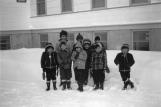10
Residential SchoolsMissionaries hoped to teach First Nation children European religion, skills, and culture. In Carmacks, the St. Luke's mission provided a day school that was taught by Reverend Swanson.
However, some of the native First Nation children were sent to residential schools far away from their home. Yukon children were either to Choutla School (Anglican) at Carcross or to Lower Post School (Catholic) in British Columbia. The children would stay for the whole year, and return home in the summer. After, a couple of months they were sent back to their school.
In 1944, Canada introduced the Family Allowance Act to provide assistance to parents. However, payment required that children attend school, which added pressure on people to send their children away to residential school.
The effects of the residential schools could not have been more devastating. Children were forbidden to speak their language, and taught only European culture. When they returned home in the summer, they had trouble relating to their families. When they finally finished school, they hadn't learned any of the skills and beliefs that had sustained their people for thousands of years. The residential schools were like cutting a link out of a chain, and the effects are still being felt today.
In the late 1950's, the public schools were opened to First Nations people. The missionaries soon closed their residential schools and people started going to the Carmacks school instead.
In the early 1960's, some children styed at Yukon Hall in Whitehorse when attending school. During the holidays they were sent home to be with their families. Sometime in the early 1980's Yukon Hall was closed down.
11
Carmacks students at Lower Post Residential SchoolDate not available
Lower Post, British Columbia
 Credits:
Credits:(Yukon Archives PHO 372 88/150 #34)